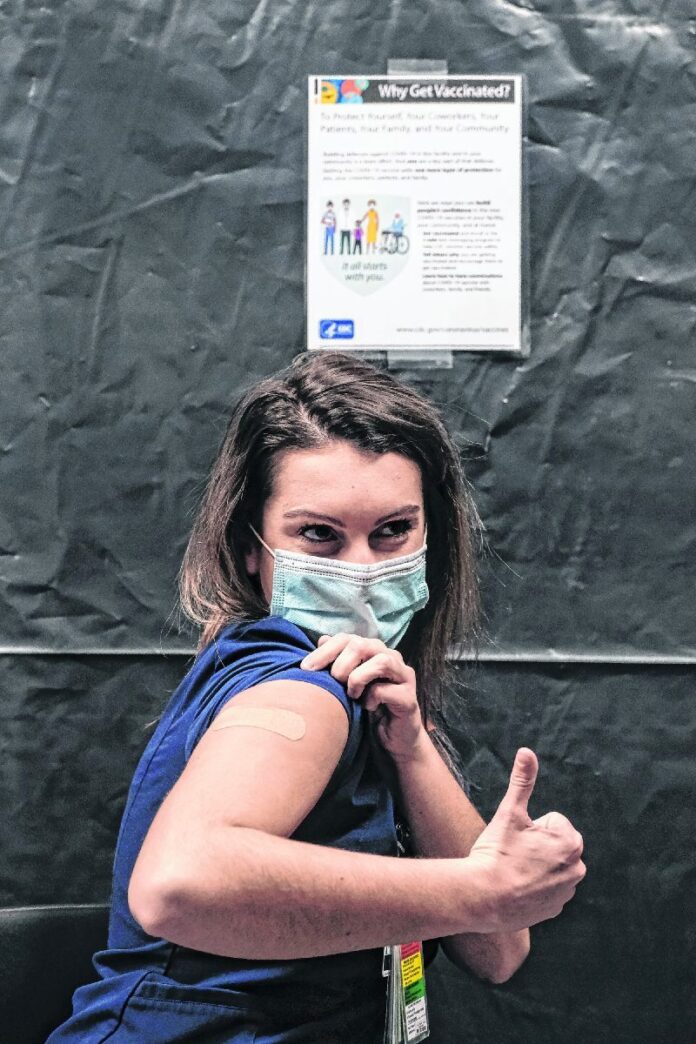
COVID-19 vaccine hesitancy in Bartholomew County markedly declined over the first six months of the year, though about 1 in 4 residents still say they are on the fence or definitely won’t get vaccinated, a new data tool shows.
The online tool, published by the Institute for Health Metrics and Evaluation at the University of Washington School of Medicine, is based off surveys conducted through Facebook and offers a glimpse at how many people in Columbus and the surrounding area may be hesitant — or downright refusing — to roll up their sleeves and get vaccinated against COVID-19.
During the first week of January, about 52% of respondents from Bartholomew County expressed some degree of vaccine hesitancy, the data shows. That number had fallen to about 25% of respondents by the end of June.
The data also suggests that about 9% of unvaccinated Bartholomew County residents may be open to the idea of getting vaccinated, though 16% — about 1 in 6 — said during the last week of June that they definitely wouldn’t get vaccinated if a vaccine were offered to them.
As of Friday morning, about 46.8% of Bartholomew County’s total population was fully vaccinated as of Thursday morning, including about 55.6% of those who are eligible, according to the Indiana State Department of Health.
However, most infectious disease experts agree that about 70% to 80% of the total population will need to be fully vaccinated to stop the uncontrolled spread of COVID-19.
The purpose of the data tool, researchers say, is to help health officials and policymakers geographically target vaccination efforts where they could have the most impact.
Bartholomew County Health Officer Dr. Brian Niedbalski, who also practices family medicine at MyCare Family Med, said the estimated decline in local vaccine hesitancy is “encouraging” and remains hopeful that less hesitancy will translate into more people getting vaccinated.
“In my personal practice, I have detected a little less hesitancy in regards to the vaccine,” Niedbalski said. “It is encouraging to see those countywide percentages, too. I am hopeful that there might be those late to the party in regards to vaccination that will choose to step forward and get vaccinated.
Local differences
The vaccine hesitancy data also shows some differences within Bartholomew County, with respondents living in more rural areas of the county at times being more likely to express vaccine hesitancy than those living closer to the Columbus city limits.
For instance, about 1 in 3 respondents, or 34%, living in the 47246 zip code, which is located in and around the town of Hope, expressed some level of hesitancy during the week of June 25, according to the most recent data on record.
By comparison, 19.6% of respondents living in the 47203 zip code expressed hesitancy, as did 27.5% of those living in the 47201 zip code, which represent Columbus residents.
The data also shows drastic differences between Bartholomew County and some neighboring counties, including Jackson County, where about 49% of respondents expressing hesitancy — the highest of any county in the state.
In Jennings County, about 1 in 3 respondents said they were on the fence or would definitely not get vaccinated.
The hesitancy figures also mirror vaccination rates.
Just over 61% of eligible people in the 47203 zip code were fully vaccinated as of Thursday morning, as were nearly 58% of those in the 47201 zip code, according to the Indiana State Department of Health.
But just 43% of people in the Hartsville area, 42% in the Hope area and 35% in and around Elizabethtown and Azalia were fully vaccinated as of Thursday, state records show.
About 40% of Jackson County residents were fully vaccinated as of Friday, as were nearly 31% of Jennings County residents.
Unvaccinated threat
The publication of the data tool comes as the Centers for Disease Control and Prevention says the COVID-19 outbreak in the U.S. is becoming “a pandemic of the unvaccinated,” the The Associated Press reported.
Cases of COVID-19 in the U.S. increased about 70% over the last week, while hospitalizations rose 36% and deaths shot up 26%, the CDC said. Nearly all hospital admissions and deaths are among the unvaccinated.
And the federal government expects cases to increase in the weeks ahead because of spread in communities with low vaccination rates.
Locally, health officials say people have given several different reasons for why they are choosing not to get vaccinated, including, among others, that the shots weren’t studied long enough, the vaccine is not fully approved by the U.S. Food and Drug Administration and concerns about possible side effects.
Some people are just saying “I’ll just take my chances” against a virus that has sickened at least 19,634 people in Bartholomew, Brown, Decatur, Jackson and Jennings Counties, sent 4,180 people to hospital emergency rooms and killed at least 418 people.
Health experts across the country have stressed that the vaccines are safe and were held to the same “rigorous” safety and effectiveness standards as all other vaccines.
Pfizer and its partner BioNTech said in May that they had started the process of applying for full FDA approval of their COVID-19 vaccine. The FDA granted emergency use authorization to the vaccines after independently reviewing safety and efficacy data from the vaccine trials.
“I am encouraged that as a county we have vaccinated 55% of the eligible population,” Niedbalski said. “That is top 10 in the state. There is hope we can move that number a little higher as the vaccine is now available in primary care offices.”
Currently, vaccination efforts in Bartholomew County are shifting toward primary care offices as Columbus Regional Health prepares to close its standalone clinic near the hospital campus in Columbus, where officials have administered at least 41,430 vaccine doses — enough to fully vaccinate 20,715 people.
Local health officials are optimistic that shifting vaccinations to primary care offices will allow more people to hear the “non-politicized scientific truth” about the safety of the vaccines and allay concerns they may have, said Dr. Raymond Kiser, medical director of hospital care physicians at CRH.
“There’s already good data that suggests that those people who have hesitancy for whatever the reason will respond much better to advice and conversation with a health care provider to kind of walk through what their concerns are,” Kiser said.
“I still think there some people out there (nationally) who want to get the vaccine but it’s just difficult for them because of transportation issues, because of work problems,” Kiser added. “…For Columbus, I think most people have had access to the vaccine if they wanted (it).”




